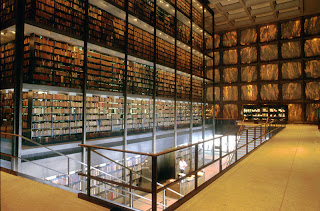On March 4, 2011, I visited the Beinecke Rare Book and Manuscript Library on the Yale University campus with Diane Gaston and her kind DH who drove us up from Washington, D. C. I have written several times in the last month about our visit to the exhibition Thomas Lawrence: Regency Power and Brilliance at the Yale Center for British Art. We didn’t have time for a lot more on our visit to New Haven, CT, but we did take a turn around the very fascinating Beinecke Rare Book Library, just a few blocks from the YCBA. Jim Perkins snapped this of the two intrepid researchers on our way across campus.
The Yale campus is renowned for its Gothic architecture, such as this tower, but it also has many modern buildings, some of which are truly masterpieces of contemporary architecture by some of the world’s leading practitioners. The neo-Gothic buildings are quite beautiful if hardly practical in today’s technological age.
Peeking through this elaborate gate, one could expect to see dedicated students and brilliant professors in the same rarefied atmosphere of the greatest universities — it almost could be Cambridge or Oxford’s dreaming spires. Alas, we did not have time to investigate and any students we saw were either hurrying along with their phones to their ears — or practicing jumps on their skateboards.
Nevertheless, we were a bit disappointed when we came upon the Beinecke’s building. While the proportions were good, it looked rather bland, a grid upon a white surface without embellishment. It was designed by Gordon Bunshaft (1909-1990), of Skidmore Owings and Merrill, a student of the 20th century’s greatest architects such as Mies van der Rohe. Bunshaft also designed Lever House, on NYC’s Park Avenue, the Hirshhorn Museum of the Smithsonian Institution in Washington, D. C., and other iconic buildings. But we quickly changed our opinions when we entered this magnificent structure.
In my photograph, you can see the glass-enclosed collection displayed in all its glory. On the right, you see some of the sections of translucent marble that bring the filtered sunlight inside. The effect is breathtaking. I will include a better photo from their website (link below). Around the outside of the glass-wrapped stacks is exhibition space, occupied by several treasures — a copy of Audubon’s Birds of America — and a Gutenberg Bible. Other than the first picture below, the photos are mine. I love a museum that allows photos — why not, I always wonder when there are restrictions on cameras without flashes.
 |
| Yale University’s Beinecke Rare Book and Manuscript Library, completed 1963 It is said that this treatment of glass enclosed books was the inspiration for the British Library’s glass tower of George III’s collection in their new building of 1997. Among of the Beinecke’ treasures are two sets of The Birds of America, the works of John James Audubon (1785-1851). Audubon was born in Haiti and came to the US in 1803. For more than ten years he drew and painted American birds. According to the text panel, each book contained 425 plates showing 1055 birds, mostly drawn from life. To the left is the page showing the white-winged Crossbill. The plates were engraved and hand colored ion Edinburgh and London; the books were sold by subscription. To the right is Audubon’s Orchard Oriole in one of the two volumes of The Birds of America in Yale’s Beinecke Rare Book and Manuscript Library. The building was a gift of the Beinecke family in 1963; it is one of the world’s largest buildings devoted to the preservation of rare books and manuscripts. In addition to the visible stacks, there are several floors underground for archived of precious books and papers. Collections range from medieval Every day a page is turned in the Beinecke’s Gutenberg Bible, one of five complete Gutenbergs in the U.S. To the left is the page we saw, not too elaborate, but certainly an interesting design. Johann Gutenberg of Mainz, Germany, printed these Bibles about 1455, the world’s first books printed with moveable type. There are 21 complete Gutenberg Bibles in the world and another 20+ incomplete versions. This copy, once in the Benedictine Abbey in Melk, Austria, was purchased by Mrs. Edward S. Harkness for presentation to Yale as a memorial for Mrs. Stephen V. Harkness. At right is one of the many displays around the Beinecke Library as part of an exhibition called Psyche and Muse, shown until June 13, 2011. According to the brochure, it “explores cultural, clinical and scientific discourse on human psychology and its influend on twentieth-century writers, artists, and thinkers.” I am sure that F. Scott Fitzgerald and his wife Zelda and their friends provided rich source material for the exhibition’s essays. Diane and I could have spent hours investigating each display and panel. However, another visit to Thomas Lawrence beckoned and we had to pass up a close examination. |
Oh, Vicky, thanks so much for the reminder of our adventure at Beinecke Library!
The Psyche and Muse exhibit was perfect for me, because of my former life as a mental health therapist.